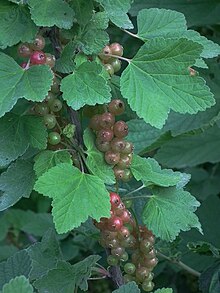Ribes spicatum
| Ribes spicatum | |
|---|---|

| |
| Unripe fruit | |
| Scientific classification | |
| Kingdom: | Plantae |
| Clade: | Tracheophytes |
| Clade: | Angiosperms |
| Clade: | Eudicots |
| Order: | Saxifragales |
| Family: | Grossulariaceae |
| Genus: | Ribes |
| Species: | R. spicatum
|
| Binomial name | |
| Ribes spicatum | |
| Synonyms[2] | |
|
List
| |
Ribes spicatum, the downy currant or Nordic currant, is a species of shrub in the family Grossulariaceae, native to northern Europe and northern Asia.[2] Its bright red berries are edible and quite good‑tasting. It can be differentiated from the more common redcurrant (Ribes rubrum) not so much by its leaf hairs, as these tend to fall off as the leaf ages, but by other characteristics: the leaves of R. spicatum are a duller and darker green than R. rubrum with its paler yellowish‑green leaves. R. spicatum holds its leaves at a right angle to the stem, whereas R. rubrum leaves are less erect, markedly distinguishing the overall form of the bushes. R. spicatum has green petioles, but R. rubrum petioles are more orange‑ish.[3]
Subspecies
[edit]The following subspecies is currently accepted:[2]
- Ribes spicatum subsp. hispidulum (Janch.) L.Hämet-Ahti
References
[edit]- ^ W.Withering, Arr. Brit. Pl. ed. 3, 2: 265 (1796)
- ^ a b c "Ribes spicatum E.Robson". Plants of the World Online. Board of Trustees of the Royal Botanic Gardens, Kew. 2017. Retrieved 19 September 2020.
- ^ Richards, A.J. (31 January 2015). "Ribes spicatum Robson Downy Currant. Species Account" (PDF). bsbi.org. Botanical Society of the British Isles. Retrieved 19 September 2020.
With practice, bushes can be accurately identified from a distance of 10 m or more, even in mixed populations.
